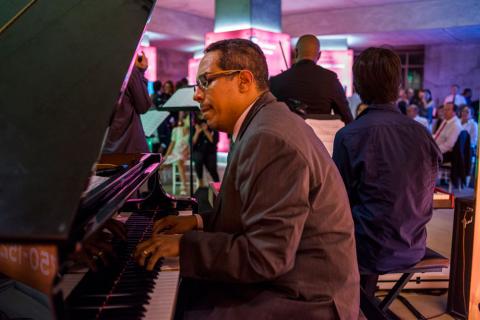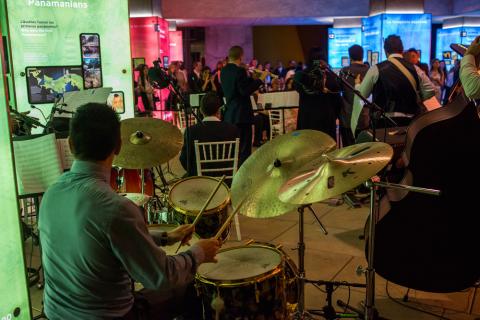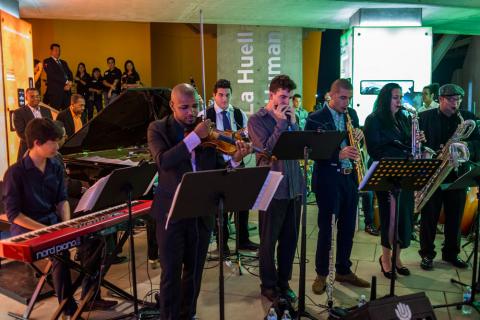Soundtrack to Change: Danilo Perez Makes Panama’s Biomuseo Sing

Biomuseo Panama
Photo by Fernando Alda

Danilo Pérez playing at the Biomuseo

BGJI students and faculty playing at the Biomuseo

BGJI students and faculty playing at the Biomuseo

BGJI students and faculty playing at the Biomuseo
On a dry afternoon in January 2009, Panamanian pianist Danilo Pérez assembled a musical ensemble beneath a cluster of beams and joists situated on the southern coastline of Panama City, Panama. The players—some from Berklee, some indigenous Kuna people—wore hardhats. Jazz drifted into the Pacific mouth of the Panama Canal. The Biomuseo worksite was blessed.
Biomuseo is a Frank Gehry-designed biodiversity museum that opened this past October and now occupies the stretch of coastline where Pérez and company once jammed. Multicolored steel panels cover the supports. School children and tourists race up the institution’s steps to peruse its permanent exhibition, “Panama: Bridge of Life.”
Biocultural Leadership and Music
The connection between Pérez and Biomuseo has grown like the structure itself, forged from the fabric of Panama and tempered by the desire to reconnect people with the natural world. Pérez is the artistic director for the Berklee Global Jazz Institute (BGJI), a program dedicated to developing conscious musicians who use their talents to bridge cultural divides, address global issues, and connect with nature.
“The problems we have are universal,” he says. “Everyone must worry about the environment, sustainability, and social issues. Musicians are therapists for the world. Music can be used as a tool for the betterment of humanity.”
With this mission in mind, Pérez develops relationships with humanitarian groups in order to expand Berklee’s impact and continue his personal outreach efforts. One of these groups is Earth Train, a Panama-based biocultural organization. It was through Earth Train that Pérez learned of Biomuseo.
“We had [Danilo] join us on one of our pioneering kayak trips,” says Earth Train founder Nathan Gray. “He walked and kayaked from our side—the Pacific side—across Kuna territory to the Atlantic coast. I think it inspired him, solidified his connection to the land, and, therefore, made his involvement with the Biomuseo natural.”
The museum has since commissioned Pérez to create a musical feature for one its eight permanent exhibitions, “The Human Path.”
Watch a video featuring Danilo Perez, BGJI's artistic director, as he talks about the the Biomuseo in Panama and how it's inspired the BGJI.
“From the initial stages of developing our exhibits, we strived to showcase work by Panamanian artists,” says Darién Montañez, Biomuseo’s director of exhibits. “We dreamed of having a Danilo Pérez soundtrack. We were sure he would be able to capture the spirit of our culture, and being a talented composer, we were sure the overall result would not only please the public but be up to par with its setting: an ambitious project that literally aims to change the world.”
An Aural Timeline of Human Development in Panama
The exhibit explores the history of human development in Panama. The space features 16 illuminated columns, each one representing a single stage in an evolutionary process that occurred approximately 15,000 years ago.
Pérez, along with Panamanian players and a few Berklee musicians, recorded a four-part composition for the exhibit. Each piece corresponds to one of four key eras: the beginning of man, the development of the native culture, colonization, and modernity.
Drums and ethereal vocalizations signify the creation of man; African rhythms denote the formation of indigenous traditions; sparse, melancholic violins hint at the destructive forces of colonialism; and electric keyboard and complex harmonies usher in the modern era.
As visitors move throughout the exhibit, the sounds mingle, producing a sort of aural timeline. Rob Jaczko, chair of Berklee’s Music Production and Engineering (MP&E) Department, recorded the sessions.
“Danilo came in with a complete musical vision,” says Jaczko. “His level of creativity and the energy that he brings to a session are why anytime he wants to work with me, I say yes.”
Berklee assistant professor Nedelka Prescod, “the daughter of proud Panamanians,” provided the vocals for the project.
“My life was always about the stories of Panama,” she says. “This was a huge opportunity. It was important to me to honor my family and where they come from. The fact that I, as someone from the next generation, was able to honor Panama, was huge.”
With Great Talent Comes Great Responsibility
According to Montañez, “Music, and all arts, are crucial to the development of a society, and Panama has a lot of work to do in those matters.” He adds, “The Biomuseo wants to be instrumental in fostering this development and we see this piece as a great opportunity to invite all visitors to appreciate the arts and explore their potential to make a difference.”
“As a member of the Berklee community, I believe these collaborations are truly important,” says Pérez, who hosted clinics for aspiring local musicians and, along with other BGJI musicians, jammed at his Panama venue, Danilo’s Jazz Club, in conjunction with the Biomuseo’s “hardhat debut.”
“We can promote peace and sustainable practices; we can bring hope to the world,” Perez adds. “When you have a talent, you also have a responsibility to your community.”
